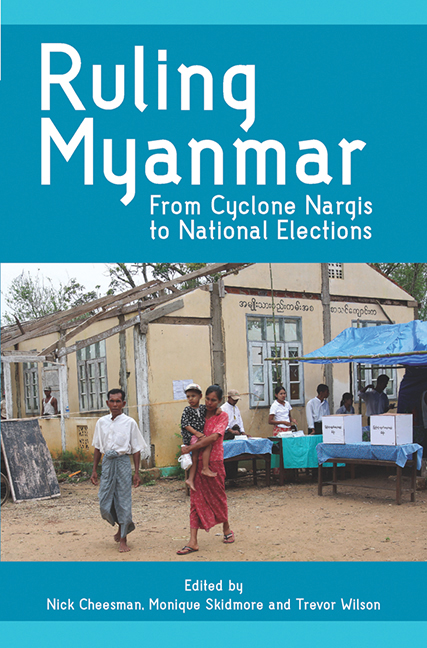Book contents
- Frontmatter
- Contents
- List of Tables
- List of Figures
- Background on ANU 2009 Myanmar/Burma Update Conference
- Acknowledgements
- Contributors and Editors
- Note on Terminology and Geographical Names
- Map of Myanmar
- Part I Overview
- Part II Political Legitimacy, Governance and Justice
- 2 2010 and the Unfinished Task of Nation-building
- 3 Burma's Political Transition: Implications for U.S. Policy
- 4 Sovereignty in the Shan State: A Case Study of the United Wa State Army
- 5 Governance and Legitimacy in Karen State
- 6 The Incongruous Return of Habeas Corpus to Myanmar
- Part III Economic Development, the Rural Economy and Labour Rights
- Part IV The Role of International Cooperation and Governance
- List of Abbreviations
- Index
4 - Sovereignty in the Shan State: A Case Study of the United Wa State Army
from Part II - Political Legitimacy, Governance and Justice
Published online by Cambridge University Press: 21 October 2015
- Frontmatter
- Contents
- List of Tables
- List of Figures
- Background on ANU 2009 Myanmar/Burma Update Conference
- Acknowledgements
- Contributors and Editors
- Note on Terminology and Geographical Names
- Map of Myanmar
- Part I Overview
- Part II Political Legitimacy, Governance and Justice
- 2 2010 and the Unfinished Task of Nation-building
- 3 Burma's Political Transition: Implications for U.S. Policy
- 4 Sovereignty in the Shan State: A Case Study of the United Wa State Army
- 5 Governance and Legitimacy in Karen State
- 6 The Incongruous Return of Habeas Corpus to Myanmar
- Part III Economic Development, the Rural Economy and Labour Rights
- Part IV The Role of International Cooperation and Governance
- List of Abbreviations
- Index
Summary
More than twenty years have now passed since the beginning of the organization of large-scale ceasefire agreements in Burma, with Khin Nyunt having taken the historical credit for spearheading this spate of accords. The United Wa State Army, or UWSA, is one such ceasefire group (in Burmese, a nyein chan yay apwe) and claims territories in the Northern and Eastern Shan State. Particularly in the past decade, the UWSA has repeatedly engaged in combat with the Shan State Army South, at the behest — and to the potential benefit — of the Burmese Tatmadaw. While ten years ago, the UWSA's tenth-anniversary celebrations were marked with fanfare, and attended and sanctioned by Khin Nyunt himself, the ceasefire group's twentieth-anniversary celebrations in April 2009 were markedly different in tone. Although the celebrations in the Wa capital of Panghsang were attended by roughly twenty thousand people and 2,400 UWSA troops, only a handful of lower-ranking SPDC military men were in attendance in 2009. Arguably, this diminished enthusiasm on the part of the SPDC foreshadows a lesser role ascribed to the ceasefire groups in the upcoming elections, and whether this will be a viable option for these organized groups in the context of the Shan State political economies remains to be seen.
These tense relations, with some observers waiting to see which side fires first will certainly have a significant effect on the political future of the Shan State. Of particular interest for the context of this conference on governance in the region is the Wa organizations’ overt refusal to accept and participate in the SPDC's recent ultimatum that they become a proxy force, or a Border Guard Force (BGF) ultimately supervised by the Tatmadaw (The Irrawaddy, 20 April 2010). All of the major ceasefire groups were urged to join the fold of the Burmese Tatmadaw, and out of the seventeen ceasefire groups given this ultimatum, the largest of these groups, including the UWSA as well as the Kachin Independence Organization (KIO), have rejected these proposals, claiming that they would only negotiate with a democratically elected government in the future (The Irrawaddy, 18 May 2010).
- Type
- Chapter
- Information
- Ruling MyanmarFrom Cyclone Nargis to National Elections, pp. 52 - 62Publisher: ISEAS–Yusof Ishak InstitutePrint publication year: 2010

